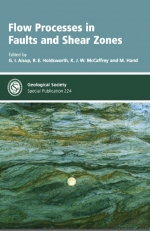Добрый день, Коллеги. Важное сообщение, просьба принять участие. Музей Ферсмана ищет помощь для реставрационных работ в помещении. Подробности по ссылке
Flow processes in faults and shear zones / Процессы течения в разломах и зонах смятия
Faults and their deeper-level equivalents, shear zones are localized regions of higher strain which effectively accommodate differential movement in the Earth's crust and mantle during deformation of the lithosphere. Shear zones may be more precisely defined as approximately tabular regions of concentrated deformation and flow across which adjacent relatively undeformed rock units are offset. They are recognized at all sizes from micro to plate boundary scale (Ramsay 1980; Sornette et al. 1990) (Figs 1 & 2). Faults and shear zones are therefore important examples of the heterogeneous nature of deformation in natural rocks, and profoundly influence the location, architecture and evolution of a broad range of geological phenomena (e.g. Rutter et al. 2001). The topography and bathymetry of the Earth's surface is marked by mountain belts and sedimentary basins which are controlled by faults and shear zones. In addition, faults and shear zones control fluid migration and transport, including hydrothermal fluids and hydrocarbons of economic significance (e.g. McCaig 1997). Magma transport, emplacement and eruption are also frequently controlled by faults and shear zones, as are earthquakes. Once faults and shear zones are established, they are often long-lived features prone to multiple reactivation over very large time-scales (e.g. Holdsworth et al. 1997). Faults and shear zones are typically arranged into complex interlinked networks that permit 3D strain in response to plate tectonic forces (Dewey et al. 1986). However, analysis of ductile shear zones is complicated as they are only directly accessible to geoscientists after exhumation to the Earth's surface. In such cases, the relationships between the observed finite deformation patterns, the preserved microstructures at any given location, and the deformation path and strain rate history are potentially difficult to resolve (e.g. Knipe 1989). It is therefore necessary to first consider the bulk deformation behaviour of the lithosphere and the nature and strength of deformed rocks at depth within shear zones. <...>




